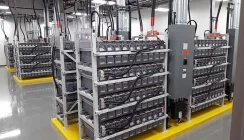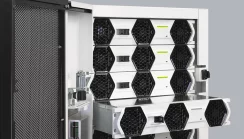Understanding the EU Energy Efficiency Directive for Data Centres
The European Union’s Energy Efficiency Directive (EED), with its stringent regulations and ambitious goals, underscores the EU’s commitment to reducing energy consumption and greenhouse gas emissions. While the directive directly targets larger facilities, there are valuable lessons for smaller data centres and (server room operations) with capacities below 500kW.
Here we explore the EU Energy Efficiency Directive and how smaller data centres, and server rooms can adapt and benefit from its principles.
The EU Energy Efficiency Directive: A Brief Overview
The EU Energy Efficiency Directive (EED), established in 2012 and revised multiple times, aims to achieve significant energy savings across various sectors. One of its core goals is a 32.5% improvement in energy efficiency by 2030. The directive mandates energy audits, reporting, and efficiency measures for large energy consumers, including data centres. In its most recent updates, the directive has increasingly focused on data centres due to their rapid growth and significant energy demands.
Five Key Provisions for Data Centres
- Energy Audits: large data centres must conduct regular energy audits to identify inefficiencies and opportunities for improvement
- Power Usage Effectiveness (PUE) Reporting: operators are required to measure and report PUE, a critical metric that assesses how efficiently a data centre uses energy
- Use of Renewable Energy: facilities are encouraged to incorporate renewable energy sources into their power mix
- Cooling Efficiency: there is a strong emphasis on improving the efficiency of cooling systems, a major contributor to energy consumption in data centres
- Data Sharing: the directive mandates that data centres share energy consumption data to improve transparency and enable benchmarking across the industry
Why Smaller Data Centres Should Pay Attention
Although the directive primarily applies to larger data centres (typically those with a capacity exceeding 500kW), smaller facilities are not exempt from market pressures and societal expectations to operate sustainably. Here are several reasons why smaller data centres should take cues from the EED:
- Anticipation of Future Regulations: Legislative frameworks often evolve, with initial thresholds eventually extending to include smaller entities. Smaller data centres that adopt EED-inspired practices now will be better prepared for potential future compliance requirements.
- 2. Cost Savings:Energy efficiency isn’t just about regulatory compliance; it’s also a smart business decision. Optimizing energy usage can significantly reduce operational costs, which is crucial for smaller facilities operating on tighter margins.
- 3. Customer Expectations: Sustainability is increasingly becoming a priority for customers and stakeholders. Data centres, regardless of size, which demonstrate a commitment to green practices can differentiate themselves in a competitive market.
- 4. Scalability and Growth: Smaller data centres often aspire to grow. Establishing energy-efficient practices early creates a scalable operational foundation, avoiding the need for costly retrofits later.
7 Lessons from the EU Energy Efficiency Directive
1. Embrace Energy Audits
Even if not legally mandated, smaller data centres should conduct periodic energy audits to identify inefficiencies. Key areas to examine include:
- Server utilisation rates
- Cooling system performance
- Power distribution inefficiencies
Conducting an audit helps prioritise investments and operational changes that yield the greatest energy savings.
2. Measure and Monitor PUE
Power Usage Effectiveness (PUE) is a simple yet powerful metric for assessing energy efficiency. Smaller data centres should:
- Install monitoring systems to measure PUE in real-time
- Set benchmarks and goals for improvement
- Regularly review PUE data to identify trends and areas for action
3. Optimise Cooling Systems
Cooling can account for up to 40% of a data centre’s energy consumption. Smaller facilities can adopt several strategies to improve cooling efficiency:
- Implement hot aisle/cold aisle containment
- Use free cooling methods where feasible
- Invest in energy-efficient HVAC systems and variable speed drives
- Regularly maintain and clean cooling equipment to ensure optimal performance
4. Impement Renewable Energy Usage Programs
While smaller data centres may lack the resources for large-scale renewable installations, they can:
- Partner with renewable energy providers
- Purchase renewable energy credits (RECs)
- Explore on-site renewable options, such as rooftop solar panels, if space permits
5. Focus on Server Efficiency
Servers are the heart of any data centre, and their efficiency directly impacts overall energy use. Smaller data centres should:
- Consolidate workloads to maximise server utilisation
- Decommission outdated and inefficient servers
- Consider virtualization to reduce the number of physical servers required
6. Adopt Data-Driven Decision Making
Smaller facilities can benefit from adopting advanced monitoring and analytics tools to:
- Track energy consumption across systems
- Identify anomalies that may indicate inefficiencies
- Test the impact of energy-saving measures before full implementation
7. Promote Staff Training and Awareness
Energy efficiency is not solely about technology; it’s also about culture. Smaller data centres can:
- Train staff on energy-saving practices and technologies
- Encourage a culture of sustainability within the organization
- Involve employees in brainstorming and implementing efficiency initiatives
Real-World Examples
Smaller data centres across Europe are already drawing inspiration from the EED. Here are a few examples:
- Custodian Data Centre (UK): located in Kent, this smaller data centre has integrated innovative cooling technologies, including fresh-air cooling and advanced thermal management systems. By utilising renewable energy and achieving a PUE below 1.2, Custodian demonstrates that smaller facilities can lead in energy efficiency and sustainability.
- Hydra Data Centre (United Kingdom): based in Scotland, Hydra has adopted an innovative approach by using natural cooling from the local climate. This facility also integrates wind energy sourced from nearby wind farms, achieving a PUE of 1.18. By harnessing local resources, Hydra exemplifies how smaller data centres can align with regional strengths to achieve energy efficiency.
- EcoDC (Sweden): this facility, with a capacity under 500kW, has implemented advanced free cooling techniques, achieving a PUE of 1.15.
- GreenBytes (Germany): a small data centre that relies entirely on renewable energy, GreenBytes has also optimized server utilization, reducing its energy consumption by 20%.
- DataHub (Netherlands): by adopting modular design and energy-efficient cooling, this small-scale data centre has reduced its carbon footprint while maintaining scalability.
Challenges for Smaller Data Centres
Despite the benefits, smaller data centres may face unique challenges in implementing EED-inspired practices:
- Limited Budgets: smaller facilities often operate with tighter financial constraints, making large-scale investments difficult
- Resource Constraints: a lack of dedicated energy management staff can hinder the implementation of efficiency measures
- Technology Gaps: smaller facilities may not have access to advanced monitoring and analytics tools
Overcoming the Challenges
To address these challenges, smaller data centres can:
- Start Small: focus on low-cost, high-impact measures such as sealing leaks in cooling systems or improving server utilisation
- Leverage Grants and Incentives: explore EU and UK national funding opportunities for energy efficiency projects
- Collaborate: join industry groups (such as the Data Centre Alliance – https://dca-global.org) or partner with larger data centres to share knowledge and resources.
- Invest in Modular Solutions: modular data centre designs allow for incremental scaling and energy-efficient expansion and this can include modular UPS systems and cooling solutions.
- Environmental Monitoring: implement an environmental monitoring system to gather data on temperature, humidity, energy and power usage throughout the server room space, which can be used to monitor the impact of future improvements over time.
The Role of Artificial Intelligence
According to Goldman Sachs AI could drive up data centre energy by 160% by 2030. This is due to the larger CPUs needed to do the data crunching for AI driven queries, calculations and research.
See: https://www.goldmansachs.com/insights/articles/AI-poised-to-drive-160-increase-in-power-demand
However, the wider adoption of AI could also have an inmpact in energy efficiency modelling, especially digital-twin comparisons. This would allow organisations with the right environmental monitoring data to model their current states and compare how modifications and upgrades to the existing datacentre setup could impact power usage, cooling and energy efficiency. We are only just at the start of the curve with this and monitoring companies such as AKCP are developing CFD modelling and digital twin software tools to help data centre operators to plan energy efficiency improvements, prepare businesses cases and as important, monitor the impact of such programs.
Conclusion
The EU Energy Efficiency Directive is a powerful catalyst for change in the data centre industry. While its direct mandates may not currently apply to smaller facilities, the principles it promotes are universally beneficial. By embracing energy audits, optimising cooling and server efficiency, leveraging renewable energy, and fostering a culture of sustainability, smaller data centres can reduce costs, enhance competitiveness, and prepare for a greener future.
Incorporating these lessons is not just a response to regulatory trends; it is an investment in resilience, sustainability, and long-term success. For smaller data centres, the journey toward energy efficiency is an opportunity to lead by example and demonstrate that size is no barrier to impact.
Server Room Environments are an Endorser to the EU Code of Conduct on Data Centre Energy Efficiency. For more information on our consultancy, audits and energy efficiency related services, please contact our Projects Team.


























